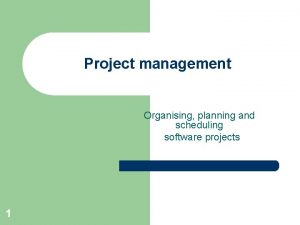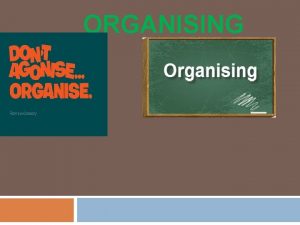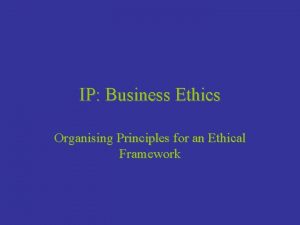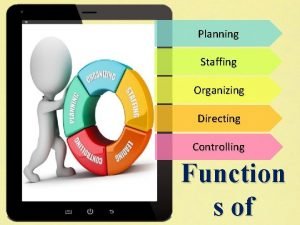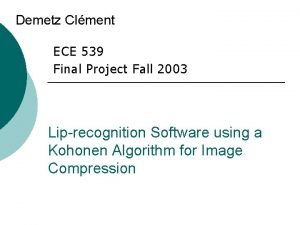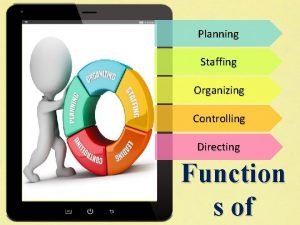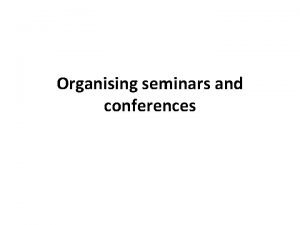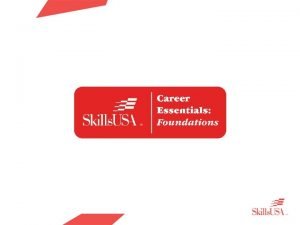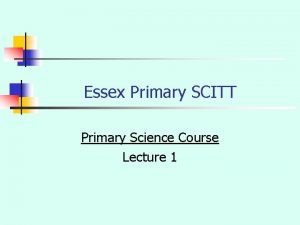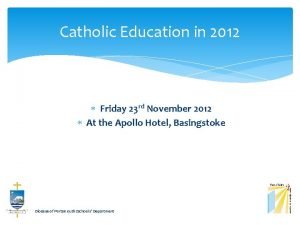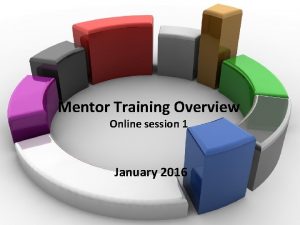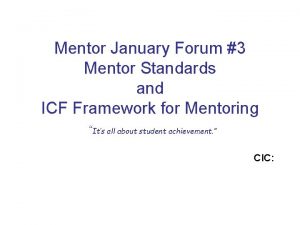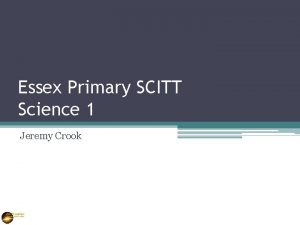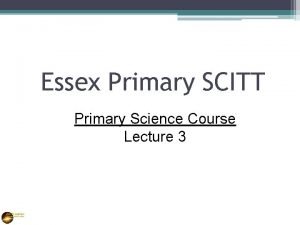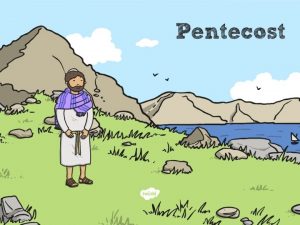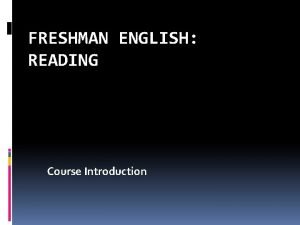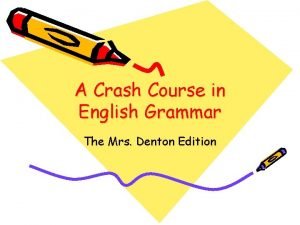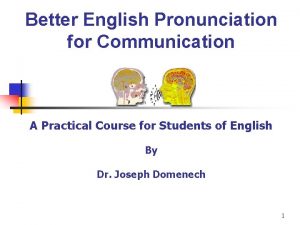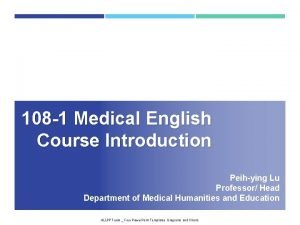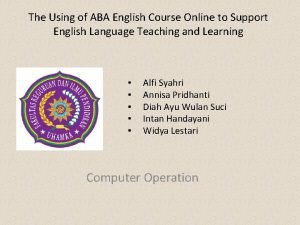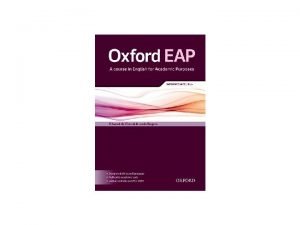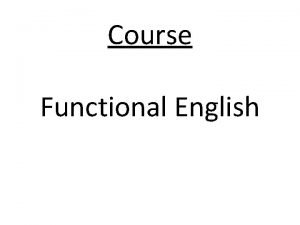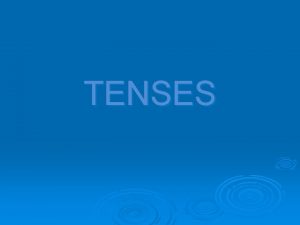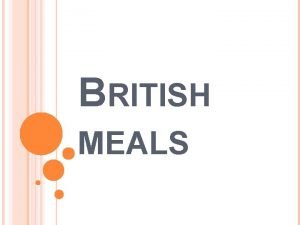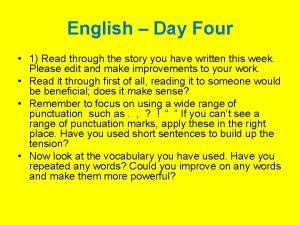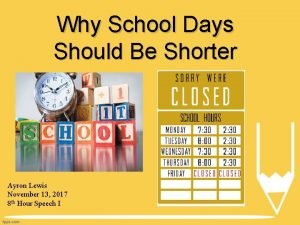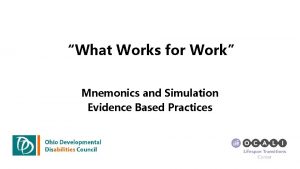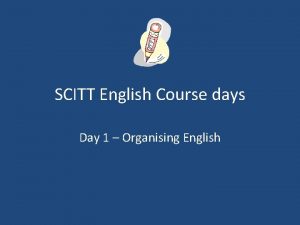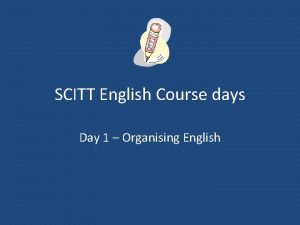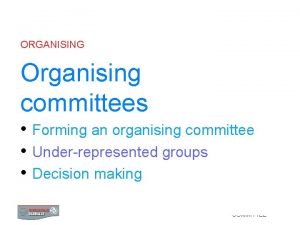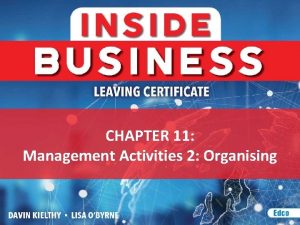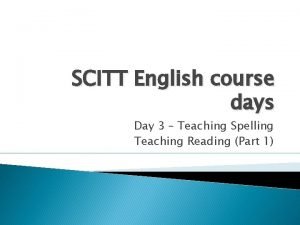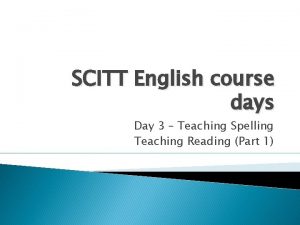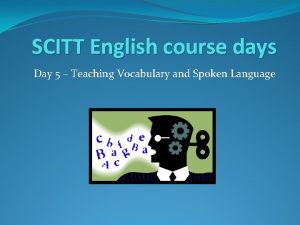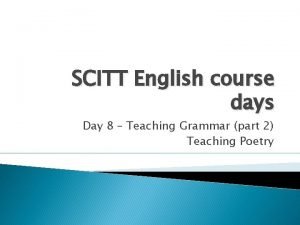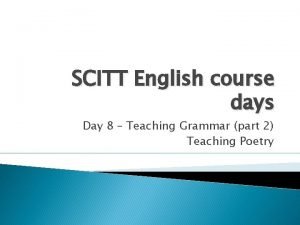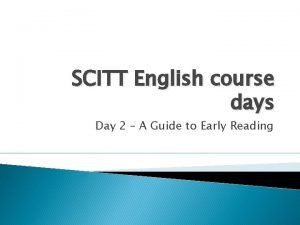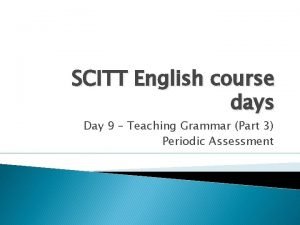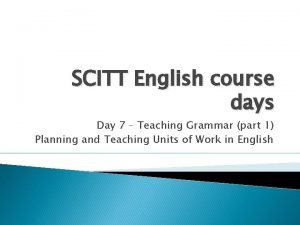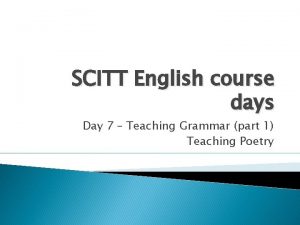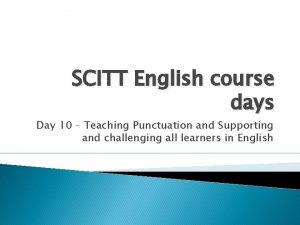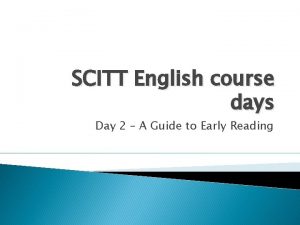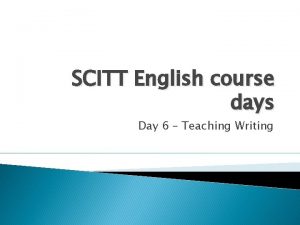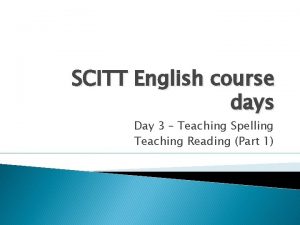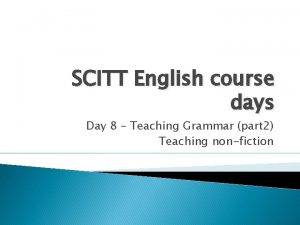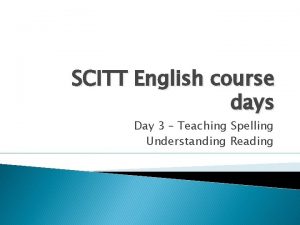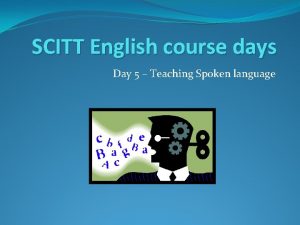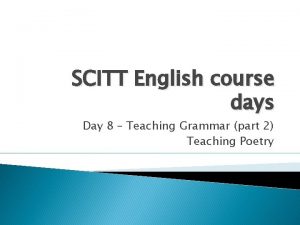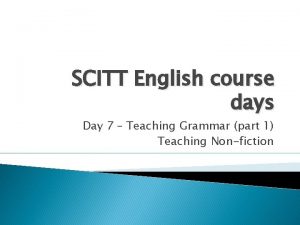SCITT English Course days Day 1 Organising English



















































- Slides: 51

SCITT English Course days Day 1 – Organising English

Which book?

You and English • Think of the way in which you became a reader or a writer. What particular books, people, situations, contexts were significant for you? • What was your favourite book? Why?

An overview of the course • Day 1 – Organising English • Day 2 – A Guide to early reading • Day 3 (i)– Teaching handwriting and spelling • Days 3 (ii) and 4 – Teaching reading • Day 5 – Teaching spoken language

An overview of the course • Day 6 – Teaching writing • Day 7 – Teaching grammar (1) and teaching poetry • Day 8 – Teaching Grammar (2) and teaching non-fiction • Day 9 – Periodic assessment in literacy + Supporting and challenging all learners • Day 10 – Motivating learners

Your audit • Work with a partner and the audit answer sheets. • What are your priorities? • How will you fill the gaps in your knowledge?

Day 1 - Organising literacy • You will – Gain an overview of the course – Understanding the range of our language use – Be introduced to English in the National Curriculum, the Primary Literacy Framework and The English Planning Kit – Understand the teaching sequence and the principles of medium and short term planning

What children need to learn

Modes of language Productive Receptive • Speaking • Writing • Listening • Reading

Compare and contrast • What does a good listener do? • What does a good reader do? • What’s different and what’s the same?

Compare and contrast • What does a good speaker do? • What does a good writer do? • What’s different and what’s the same?

A recent history of primary English • • 2000 National Curriculum Primary Literacy Strategy Renewed Primary framework 2014 National Curriculum

The 2014 National Curriculum • Spoken Language • Reading – Word reading – Comprehension • Writing – Transcription – Composition • 2 statutory appendices – Spelling – Grammar and punctuation

Organising the curriculum

Where in the school day have you seen children working on English?

Balancing knowledge, skills and understanding • To teach knowledge and skills, children must be involved in ‘doing’ • To teach understanding, children must apply knowledge and skills to lots of situations

The Renewed Literacy Framework http: //webarchive. nationalarchives. gov. uk/20100612 050234/nationalstrategies. standards. dcsf. gov. uk/pri mary/primaryframework/literacy/ or Google ‘renewed literacy framework’

Levels of Access 1. 2. 3. 4. The objectives The long term plans Unit outlines Planning exemplification

The strands of objectives 1. 2. 3. 4. 5. Speaking Listening and responding Group discussion and interaction Drama Word recognition: decoding (reading) and encoding (spelling) 6. Word structure and spelling 7. Understanding and interpreting texts 8. Engaging with and responding to texts 9. Creating and shaping texts 10. Text structure and organisation 11. Sentence structure and punctuation 12. Presentation

Long term plans - Teaching in units Narrative 16 -17 weeks UNIT 1 Stories with familiar settings * (4 weeks or 2 x 2 weeks) UNIT 2 Stories from a range of cultures/Stories with predictable and patterned language * (4 weeks or 2 x 2 weeks) Non-fiction 12 weeks UNIT 1 Labels, lists and captions * (1 week) UNIT 2 Instructions * (2 weeks) Poetry 6 weeks UNIT 1 Using the senses * (2 weeks) UNIT 3 Traditional and fairy tales * (includes plays) (4 -5 weeks or 2 -3 + 2 weeks) UNIT 3 Recount, dictionary * (2 weeks) UNIT 4 Information texts * (5 weeks) UNIT 2 Pattern and rhyme (2 weeks) Numbers of weeks identified for each unit are suggestions only UNIT 4 Stories about fantasy worlds * (4 weeks or 2 x 2 weeks) UNIT 5 Recount (fact and fiction) * (2 weeks) UNIT 3 Poems on a theme (2 weeks)

Phases • Phase 1 – reading, understanding and interpreting • Phase 2 – reading and analysing • Phase 3 – application into writing The Teaching Sequence varies from unit to unit

Unit Outlines (1) – Y 1 example Phase 1 • Read, compare and contrast a range of fantasy world settings from different text sources. Identify objects found in the settings that make them different from the world around us. Create fantasy settings using knowledge from shared reading. Phase 2 • Orally compose an adventure narrative. Drama techniques and digital photographs enable children to record their ideas and develop the pattern of conflict and resolution in a narrative. Phase 3 • Model the use of visual plans to support writing. Apply sentence-level skills developed in previous guided sessions. Compose adventures in fantasy settings applying the concept of problem and resolution using interactive whiteboard (IWB) software.

Unit Outlines (2) – Y 1 example Overview • Read stories about fantasy worlds, for example imaginary lands, space, animal homes. Visualise settings, talk about what is new or unexpected and predict how characters will look and behave in these settings. Make links with children's experience, for example, what would you do if you found yourself here? Compare and contrast stories with different settings and encourage children to express preferences. • Identify the main characters and events in a story. Children retell orally with main events in sequence. • Watch a short performance or film version of a story with a fantasy setting. Ask children to identify the key features and express views about, for example, how they created a sense of excitement. Children write about a significant incident from the story that was performed. • Read several short stories with similar imaginary settings. Ask groups of children to make predictions about what will happen in that type of story and how characters will behave. They check their predictions by reading further stories. • Create an imaginary setting and characters with the class. Explore story ideas using discussion and role-play. Record the main events for a class story based on children's suggestions and tell the story orally. Children then write their own version of the story, using or adapting the class ideas. Support children in writing stories with a clear beginning, middle and end. Each part has more than one sentence and events are sequenced logically. The stories could include good and bad characters and examples of story language.

Planning Exemplification • • Objectives Prior Learning Teaching Sequence Assessment Children’s targets Key aspects of Learning Resources

Activity • Explore a unit • What are the strengths of following such exemplification? What are the issues?

The English Planning Kit • A resource to enable the 2014 Primary National Curriculum for English to be planned and delivered coherently and effectively. • The 2014 Primary English Curriculum provides limited progression and broad objectives. This document provides smaller learning steps based on these and a more detailed progression • It suggests additional objectives where gaps or weaknesses have been identified

The English Planning Kit • Objectives are – Cumulative – In strands and terms – Short and long term – Black and purple

How the EPK is organised • • • Introduction and notes Termly objectives Strand progressions Text type progression Appendices – Writing style guide – Story structures – Example half termly planner

Strands in the EPK • Spoken language – Speaking – Listening – Discussion – Drama • Reading – Word reading – Being a reader – Comprehension – Being a researcher

Strands in the EPK • Writing – – – Planning Composing Evaluating Grammar and vocabulary Punctuation • Transcription – Spelling – Handwriting and Presentation

Comprehension sub-strands Clarifying Imagining Answering questions Predicting Summarising Inferring Understanding text organisation Understanding writers’ use of language (Year 2 onwards) • Understanding purpose and viewpoint (Year 3 onwards) • Linking • •

Explore • Explore a strand • What do you notice? • Explore the autumn term in a year group • What do you notice?

The Teaching Sequence 1. 2. 3. 4. 5. 6. 7. Reading Analysing Defining Preparation and planning Shared writing Independent writing Reviewing and publishing

Example - Persuasive writing • Reading stage –Fill in the gaps with appropriate words or phrases –What gives you the clues?

Example - Persuasive writing • Analysing stage –Label anything that makes this a good piece of persuasion –Language features on the right –Structure on the left

Example - Persuasive writing • Defining stage –Share your analysis –Write a list of the key features of a persuasive text –Which are most important?

Example - Persuasive writing • Preparation stage –You want to get rid of something –Decide on your focus –Brainstorm as many reasons as possible

Example - Persuasive writing • Planning stage –Choose from your ideas and plan out what you are going to write in order

Example - Persuasive writing • Writing stage –Use your list and your plan –Try writing a few paragraphs of your persuasive writing

Thoughts, observations, questions, difficulties. . .

How schools plan for literacy

3 Levels of Planning • Long Term – A broad framework of curricular provision for each year group. Links terms to units. • Medium Term – An outline of each unit of work. Shows the sequence of units and the objectives being taught • Short Term – Show day to day teaching and differentiation

Long Term Planning Year 1 Aut 2 Main Theme My Family Fire! Bags, bottles and boxes Stories with familiar settings (4) Stories from range of cultures (4) Literacy Using the senses (2) History Family history Spring 1 Spring 2 Sum 1 Sum 2 Toys Magic and Monsters At the Seaside Labels, lists and captions (1) Stories from fantasy worlds (4) Trad and fairy tales (5) Poems on a theme (2) Recount, dictionary (2) Info’ Texts (5) Instruction s (2) Pattern and rhyme (2) Recount (2) The Great Fire of London Old and new packaging Mum, Dad, gr’parent’s toys Victorian Seaside

. Medium Term Planning Unit Duration Key objectives Texts and Outcomes resources

Short Term Planning Session 1 2 3 4 5 Objective Shared learning and teaching Independent learning Plenary Assessment criteria Guided learning

A basic English lesson

The shared session • • • A simple appropriate objective Clear explanation and instructions Children clear on what success will look like Sharp questioning Modelling – Shared reading – Shared writing • High mental productivity • Interactivity

The activity • Groups will sometimes work with an adult in a guided session • Other groups work independently on a reading, writing, word or sentence activity • This activity is usually differentiated in some way • Adults may ‘work the room’, moving learning on

The plenary • The whole class brought back together • The focus should be on children – Reflecting on their learning – Revisiting the objective – Evaluating their work • Should not just be ‘show and tell’ • Can include an activity, game, drama etc. • High mental productivity and interactivity still important

Task 1 • Find out how your school organises the teaching of English. Write a reflective log giving your thoughts and explaining why English is organised in this way.

Thoughts and questions
 Day 1 day 2 day 3 day 4
Day 1 day 2 day 3 day 4 Day 1 day 2 day 817
Day 1 day 2 day 817 Scheduling project management
Scheduling project management Difference between accountability and responsibility
Difference between accountability and responsibility What is ethics
What is ethics Planning directing controlling
Planning directing controlling Self organising map
Self organising map Staffing and controlling
Staffing and controlling Organising a seminar
Organising a seminar Planning and organizing in the workplace
Planning and organizing in the workplace Essex primary scitt
Essex primary scitt Pcp scitt
Pcp scitt Scitt moir
Scitt moir Scitt moir
Scitt moir Jeremy crook
Jeremy crook Ctsn scitt
Ctsn scitt Ctsn scitt
Ctsn scitt Essex primary scitt
Essex primary scitt Essex primary scitt
Essex primary scitt Pentecost is celebrated 50 days after easter.
Pentecost is celebrated 50 days after easter. Half brick wall
Half brick wall Course number and title
Course number and title Course interne course externe
Course interne course externe Family sis schoolmax
Family sis schoolmax Oceans apart day after day
Oceans apart day after day Day to day maintenance
Day to day maintenance As your room gets messier day by day, entropy is
As your room gets messier day by day, entropy is I don't know tomorrow
I don't know tomorrow Romeo and juliet timeline of events
Romeo and juliet timeline of events Growing day by day
Growing day by day Seed germination inhibitors examples
Seed germination inhibitors examples Conclusion of seed germination
Conclusion of seed germination Geotropism
Geotropism I live for jesus day after day
I live for jesus day after day Casting crowns dying he saved me
Casting crowns dying he saved me Day one day one noodle ss2
Day one day one noodle ss2 Dayone dayone noodles ss2 小時光 肆號麵鋪
Dayone dayone noodles ss2 小時光 肆號麵鋪 English fresh man course
English fresh man course English grammar crash course
English grammar crash course A practical course in english pronunciation
A practical course in english pronunciation Learning english course
Learning english course Medical english online course
Medical english online course Aba english course
Aba english course Oxford eap
Oxford eap Functional english course outline
Functional english course outline What is esp english for specific purposes
What is esp english for specific purposes Simple present tense i study english everyday
Simple present tense i study english everyday British meals and meal times in england
British meals and meal times in england Trees poem
Trees poem Through of the day in english
Through of the day in english Why school days should be shorter
Why school days should be shorter 30 days has september april june and november
30 days has september april june and november


